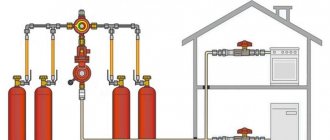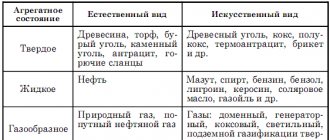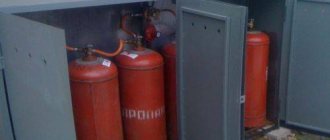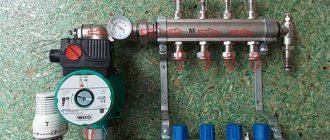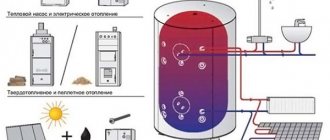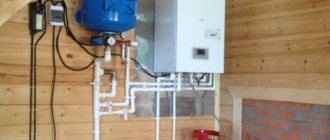Gasification of “rural” areas, unfortunately, lags behind the pace of suburban construction. And even for residents of the suburbs of administrative centers, the question of what kind of heating in a private house is the most economical if there is no gas sounds relevant. Taking into account energy prices on the domestic market, the cost of a kilowatt of thermal energy looks like this: second place - solid fuel (however, here you need to additionally ensure that you are not misled by “magic” long-burning boilers), third - liquefied gas, fourth - liquid fuel, the latter - electricity. But even in this hierarchy, not everything is so simple.
We asked ROSAVTONOMGAZ specialists, a company that occupies one of the leading positions in the autonomous gasification market, to tell us more about how to heat your home if there is no gas - about alternative home heating systems.
Heating a house without gas should ideally be combined - using traditional and alternative energy sources Source karno.ua
There are different options for heating a country house without gas, each of them is worth special attention.
Solid fuel
Not so long ago, solid fuel had no competitors. At first, firewood, and then coal, were the main types. Of course, they also burned peat, straw and even dung, but, as now, it was “local” fuel that was not widely used.
The primitive hearth in the cave is very reminiscent of a classic fireplace Source cottage.ru
With the beginning of the “gas era,” heating, firewood and coal faded into the background, but still remain in demand. Moreover, their prospects are “rosy”, since there are much more proven reserves of coal than gas, and firewood and “wood” fuel are renewable energy sources. The only modern difference is that previously only stoves or fireplaces were used to heat a house, but now a boiler is considered the main source of heat. Although there are exceptions.
They are still found today, especially when it comes to a small country house or dacha. The main advantage is absolute energy independence. Therefore, they are used when it is necessary to provide heating for a private home without gas or electricity.
Depending on their purpose, stoves can be either heating or heating-cooking. The first option includes a Russian stove and a Swedish stove, the second - a Dutch oven and a classic fireplace.
Heating and cooking stove Source bioenerga.gr
Their effectiveness largely depends on the design of the chimney system, of which there are three types:
- Straight-through. The chimney has a minimum number of bends in the direction from the firebox to the pipe. This category includes classic open-hearth fireplaces and Russian stoves. The radiator of heat is the body and part of the chimney that runs indoors or inside the wall. By the way, thanks to its special design and massiveness, the Russian stove is considered one of the most efficient. And a traditional fireplace has the lowest efficiency. And in modern realities it is more of a decoration or a means of relaxation while contemplating an open flame than a full-fledged heater.
- Duct. Combustion products are removed using a system of channels passing inside the furnace body, which not only emits, but also accumulates heat. The “Dutch” belongs to this type. It, like a Russian stove, takes a long time to warm up, but also takes a long time to cool down.
- Bell bells. Hot gases first rise into the “hood”, where they give up some of the heat, cool, fall along the walls of the hood and are drawn out into the chimney through the “hood”.
In addition to non-volatility, the advantage of classic stoves is their “omnivorousness” in relation to solid fuel. Firewood, coal, peat, briquettes - everything that can be put in the firebox with your hands and set on fire. Moreover, unpretentiousness extends to the ash content of coal and the moisture content of firewood.
The Russian stove is still relevant and can heat several rooms on two levels Source yandex.uz
The disadvantages are no less significant than the advantages:
- radiation type of transfer of thermal energy - one stove heats a house where the entire living area is contained in one or two adjacent rooms;
- labor-intensive maintenance - frequent refilling of fuel and cleaning;
- low efficiency (efficiency on average about 20%) - the fuel does not burn out completely and most of the heat “flies down the chimney” along with the smoke;
- a complex hand-made design that can only be performed by an experienced craftsman.
Modern solid fuel boilers and factory fireplace inserts do not have these disadvantages.
See also: Catalog of companies that specialize in insulating country houses.
Solid fuel boilers
Another not the worst option than heating the house. Modern solid fuel boilers have an efficiency of 80-95%. That is, the best examples of operating efficiency are at the level of gas boilers, and only three economic factors “throw them back” into second place:
- higher cost of coolant per kilowatt of thermal energy;
- higher price of equipment;
- “there are” maintenance costs (costs of transport, fuel storage and disposal of solid residues).
If we talk about cost, then in the Moscow region, heating with wood is approximately one and a half times more expensive than gas - about 90 kopecks. per kilowatt versus 53 kopecks. (at tariffs for natural gas for the second half of 2022, subject to the availability of metering devices).
Pyrolysis boilers have the highest efficiency - the wood in them burns almost completely, with minimal “solid” residue Source pogreb-podval.ru
The use of fuel pellets increases the cost per kilowatt to 1.3-1.4 rubles. and is almost comparable in price when using coal, but still 15-20% cheaper than heating with anthracite. But there are nuances here.
If the task is how to heat a house cheaply without gas, then long-burning wood boilers or pyrolysis (gas generator) models best meet this condition. The only drawback is that laying firewood is done manually and it is impossible to automate this process. Although this should be done infrequently - 1-2 times a day. Also keep in mind that you need to carefully check the information about the so-called “magic” long-burning wood-burning boilers.
Pellet or coal boilers are available with automatic loading of fuel from the bunker. And although the bunker also needs to be loaded manually, it is much larger than the volume of the firebox. A regular boiler model with a standard hopper with a capacity of 1 m³ can operate continuously from three days to a week, and with an enlarged hopper - up to 12 days (taking into account high-quality insulation of the house and low heat loss). And when it is not possible to frequently load fuel, then these boilers are the best option (if you do not take into account higher prices for equipment).
Long-burning solid fuel boilers with a large-capacity hopper do not require daily maintenance from the owners Source kaminyn.ru
Note. There are even automatic modular coal boilers with a bunker volume of up to 14 m3, their own crusher, auger fuel supply to the firebox and automatic soot removal into their own bunker - practically a mini-boiler room for a private home. Moreover, this is a domestic development and the cost of the equipment is also “domestic”.
Fireplace inserts
Modern fireplace inserts, fireplace stoves and stoves do not differ in operating principle from solid fuel boilers. They also have the function of long burning and secondary combustion. Their efficiency differs from gas generator boilers by only 5-10%, which is at least four times higher than that of classic fireplaces with an open firebox.
Demonstration model of a closed fireplace insert with a water circuit Source bestpechi.ru
How much does it cost to heat a house? Calculation scheme.
When choosing a heating system, follow the following calculation scheme:
- decide how many rooms or square meters need to be heated;
- what result is needed: temporary or permanent;
- is there gas heating;
- Are you ready to combine stove and electric heating;
- what is the heat output?
This check will help sum up the question: how much does it cost to heat a house with electricity? Pay attention not only to how much a particular installation or heater will cost, but also what related materials will be needed:
- additional rooms for a boiler room;
- fuel storage tanks;
- purchase of high-quality solid fuel;
- a place for storing solid fuel with protection from moisture, etc.
Let us present the mathematical calculation scheme in an averaged version. We take into account a house of 50 sq.m. and heating season 6 months. If your house is 100 sq.m., multiply the result by 2, 150 sq.m. - by 3, etc. Taking into account the different costs of gas, electricity and various types of fuel in the regions of the Russian Federation and the CIS, the scheme is very approximate, but we make the following general calculations:
Gas heating:
- Standard gas boiler . Natural gas consumption 2m³/hour * 2160 hours (6 months) * gas cost in your region / 0.93 (93% efficiency). For example, the cost per cubic meter. meter of gas is 9.25 rubles, which means the calculation will be as follows: 2 m³/hour * 2160 hour * 9.25 rubles / 0.93 = 42968 rubles for 6 months. This means an average of 7161 rubles per month.
- Condensing gas boiler . 2m³/hour * 2160 hours * gas cost in your region / 1.07 (efficiency 107%)
Electric boiler
- A heating element electric boiler consumes an average of 7000 kW/hour per month * the cost of electricity in your region = the cost of heating per month
- An electrode electric boiler consumes 4200 kW/hour per month * cost of electricity in your region = cost of heating per month
Liquid fuel
Average consumption per season is 2 l/hour * 2160 hours (6 months) = 4320 liters * cost of diesel in your region = cost of heating with liquid fuel for the entire season
Solid fuel
- Wood (firewood) with a solid fuel boiler power of 20 kW burns about 9 kg of fuel per hour (if we take into account the efficiency of 80%): 2160 hours * 9 kg/hour = 19440 kg (19.4 tons). Price per ton of firewood in your region * 19.4t = cost of heating with wood per season. Don’t forget to add to this amount the cost of delivering firewood to your home.
- Coal 2160 hours * 4 kg/hour = 8640 kg (8.64 tons) * price per ton of coal in your region = cost of heating with coal for a season of 6 months. Also consider the cost of delivering coal to your home.
Liquefied gas
In terms of cost per kilowatt of energy, liquefied gas ranks third.
There are different ways to deliver and store it, but the smaller the volume, the more expensive the final price. Therefore, a gas holder is needed for a permanent home, and for a small dacha, which is rarely visited in cold weather, you can get by with several 50-liter cylinders. When using a gas holder, the price of a kilowatt of heat from burning liquefied gas is 2.3-2.5 rubles, the use of cylinders raises the bar by 50 kopecks.
You can also heat yourself in different ways.
The simplest system is direct combustion of gas to produce heat without heating the intermediate coolant, pipework and radiators. For this purpose, gas convectors and infrared heaters are used. Their operating principle and design are different, but they have one thing in common - availability of equipment, compactness and operation from bottled gas. The disadvantage is the power limitation and heating of only one room. For example, infrared and catalytic gas heaters from AYGAZ have a maximum power of 6.2 kW.
With such a compact infrared heater you can heat up to 40 m2 Source vps-region.ru
On a note! You can get professional advice on autonomous gasification of a private home directly from specialists
The gas tank allows you to build a full-fledged autonomous water heating system, and the frequency of refilling depends on the volume of the container, heating area and operating mode. In terms of ease of operation and maintenance, the system ranks second after electric heating. But it requires significant initial investment for the purchase of a gas tank, its installation (usually underground) and the laying of communications (pipes for connection to the boiler and electrical cable for the tank heating system).
Another difficulty for a gas tank is choosing a location. It should be located close enough to the house and be accessible for gas refilling Source rosavtonomgaz.ru
Metal oven
As the second option for a heating device for my home, I considered stoves such as “Buleryan”, “Termofor”, “Professor Butakov”, etc.
But I like these devices the least!
According to my observations and feelings, metal stoves provide, so to speak, some kind of “burning” heat (hard infrared radiation), in contrast to brick stoves, which provide soft heat.
Despite its small size, a metal stove still takes up quite a significant amount of space in the room. This happens due to the fact that, firstly, the stove itself cannot be placed close to the wall.
And secondly, a, let’s say, high-risk zone is created around the stove; you need to be especially careful not to get burned from contact with the hot metal surface of the stove.
Due to the poor quality of the sandwich pipes used to create the chimney, fires are not uncommon.
When using slow-burning stoves, soot and tar form in the pipe. If they ignite, then the chimney - pipe can become very hot, and it will not be far from a fire.
It is necessary to clean soot from the pipe quite often. This means you will have to climb onto the roof and master the skills of a chimney sweep. Or use chemicals to remove soot from the pipe.
Metal stoves heat the room by releasing heat from their hot surface; dust also burns on the same surface, thereby not improving the atmosphere in the heated room.
The advantage of “Buleryan” type stoves is their relatively quick installation compared to a brick stove.
There is no need to pour a concrete foundation; such stoves are placed directly on the floor.
For example, a wood-burning air-heating stove “Fire-battery 9” of the Termofor brand, for heating a room with a volume of 200 cubic meters, has a weight of 60 kg. A renewable natural resource, firewood, is used as fuel.
A metal stove can heat a room faster than a brick stove. It heats up faster, but if you stop adding firewood to it, it cools down just as quickly.
Among metal stoves there is a wide variety of different models, shapes and designs, to suit every taste, color and budget.
There are slow-burning stoves - when one load of firewood is enough for a long time, and the wood does not burn, but smolders. Just be sure to use dry firewood.
There are stoves with a hob. By heating your home, you can cook and reheat food at the same time. Furnaces with built-in water circuit. Allows you to get a source of hot water in the house.
There are models that generate electricity from heat. Built-in thermoelectric generators will provide you with a source of electricity of 12 V and a power of at least 60 Watts.
This electricity will be enough to connect a couple of energy-saving light bulbs and charge a laptop or phone.
Since there is a wide variety of metal stoves, the price range is quite large. To heat my house with a volume of 110 cubic meters. you would need, for example, a stove “Fire-battery 7” costing 16,000 rubles.
You also need to additionally purchase sandwich pipes and other accessories to create a chimney. If you take high-quality materials to sleep peacefully, the amount will be about 25-30 thousand rubles.
In total, a metal stove would cost me about 46,000 rubles. subject to self-installation and installation of the chimney.
Liquid fuel
This is probably the last option that should be considered when solving the problem of how to heat a house if there is no gas. It's not even about the price of energy resources - they can be different. The most expensive diesel fuel allows you to obtain thermal energy at the same cost as using liquefied gas from cylinders. The price of heat when burning fuel oil is the same as that of coal-fired boilers, and “working off” practically compares heating costs to the level of natural gas. But…
In terms of equipment cost, this is one of the most expensive fuel-using systems. In addition, these boilers are “capricious”, requiring regular maintenance and the same complexity of maintenance as the fuel supply and injection systems of a diesel car. There are also disadvantages such as air pollution from liquid fuel combustion products, as well as high noise levels from the operation of the fuel pump and burner.
Maintenance of an oil-fuel boiler is much more difficult than any other Source enemcon.com
So what is the best way to heat a dacha in winter?
It is difficult to answer this question unequivocally. Heaters that are powered from the electrical network are the simplest and most convenient, but at the same time the most expensive option. Solid fuel stoves (mostly firewood or other wood-based fuels) are the cheapest, but at the same time the most labor-intensive way to heat a dacha in the cold season. Somewhere in the middle between them there is heating equipment that runs on gas.
According to experienced summer residents, it is best to use a combination of several methods to heat a house. For example, immediately after arrival you need to quickly heat the house. Here a stove will come to the rescue (both a potbelly stove and a Buleryan stove will do). When the stove stops producing heat (for example, at night), heaters come into play. Infrared heaters that have a function of maintaining a constant temperature are best suited for this purpose: the temperature in the room has dropped - the sensor has triggered and turned on the heater.
There are a lot of options for heating a country house in the cold season. How do you heat the room?
Electric boilers
Electric boilers have the highest efficiency - up to 98%. Moreover, it does not depend on the type of boiler. Heating element, electrode and induction boilers differ only in the method of heating the coolant, and they have no losses from incomplete combustion of fuel - electricity is almost completely converted into heat. In principle, it would be correct to talk not about the heating system (there is no fuel and combustion chamber), but about the heating method.
In terms of equipment cost, simplicity of design, complete automation and ease of maintenance, electric boilers have no competitors. But their cost per kilowatt of thermal energy is the highest. Although there are loopholes here.
Heating by heat pump
Heat pumps are high-tech and efficient. Their use has grown significantly in recent years. Especially in country houses. The essence of a heat pump is to take energy from water, air and earth. Accordingly, 3 models have been developed: air / water / geothermal.
There are a huge number of advantages:
- long service life, up to 50 years;
- safety: no secretions, dirt, waste;
- economical energy consumption: emits approximately 3 times more energy than it absorbs;
- diesel or gasoline are suitable for engine operation (when there is no electricity);
- the system is automatic, so there is no need to add water or control;
- the reversible function allows you to heat a country house in cold weather and cool it in hot weather;
- The requirements of regulatory authorities are not strict.
Disadvantages are present in a small number:
- expensive: the main disadvantage of heat pumps;
- The compressor operates loudly, therefore, the boiler room will have to be soundproofed.
Owners of country houses - gardeners need to take into account the essential characteristics of heat pumps. They are saturated with heat from the ground (geothermal), so the soil cools. Heat-loving seedlings on the site may suffer.
conclusions
They are disappointing. A cheaper alternative to gas heating that will work in any climate is a myth. At current gas prices, it remains the most profitable source of heat. But his prospects, alas, are gloomy: gas prices will quickly rise, and the price ratio may yet change towards electricity.
Let us repeat - this is far from the only point of view. The video at the end of the article covers this topic differently; You will probably be interested in hearing another position. Warm winters!
Today, natural gas is the most popular and affordable type of fuel for domestic needs and heating. However, fossil reserves are not unlimited, the cost of gas is rising, and connecting to the main line is often impossible or insanely expensive. This forces us to look for other, less conventional ways to heat our homes.
Should I add antifreeze?
When the temperature drops to freezing, water expands by about 11%. It's easy to imagine what happens to the pipes. Antifreeze added to water significantly increases the viscosity of water and reduces the degree of expansion. In other words, antifreeze is a salvation for the heating system.
Prudent owners who do not live in a country house in winter should definitely take care of filling up with antifreeze.
But in pursuit of the safety of the heating system, do not forget about the safety of the water supply system. If it is a tee, have time to drain the water before it gets cold. Then the water pipes will not be damaged. Antifreeze in the heating system will be useless if the country cottage has warm water floors.
The best option is to maintain the heating of a country house on duty in winter at a level of 9 - 12 degrees.
Antifreezes last an average of 5 - 8 years. Then acetic acid is released, which eats up the radiators. Don't forget to change it on time.
Solar collectors
An excellent alternative to gas heating is solar collectors. Such installations operate smoothly and economically. Collectors are ways to maintain heat in a room for a long time. But the main thing is that under good conditions they can generate electricity. Such installations have both their advantages and disadvantages.
Thus, solar collectors are absolutely safe. Installing such installations is quite simple and quick. Collectors are installed somewhere on the façade of a building. The installation will fit perfectly into the design of the house, since among a wide range you can choose the most suitable option for yourself. But most importantly, collectors provide significant savings in utility costs. Therefore, this type of installation is perfect even for low-income families.
The only drawback of such collectors is that they operate exclusively on solar energy. This determines the specifics of the installation of collectors. In regions where it is sunny almost all year round (usually the south of the country), installing collectors is completely justified. But in northern latitudes these installations will be completely useless.
Convectors and warm baseboards
The convector is also not the cheapest model, since everything depends on electricity, and energy prices are quite high.
Recently, the warm baseboard system has proven itself well, which replaced stationary radiators and works on the principle of heating a coolant liquid, which creates a heat shield around the perimeter of all rooms. This is practically the most economical home heating, which also has a beneficial effect on health, prevents the appearance of dampness and condensation, and also saves heating.
Thanks for the info. Useful, educational. I will definitely give up fuel oil.
Good afternoon Oleg. It's rare to see such constructive feedback. It is immediately clear that you have actually studied this issue for a long time and painfully. Having read everything to the end, I want to share my work with you. Just like you, I came to exactly the same heating scheme. BUT. Having sat down and considered the benefits of the night tariff for electricity, and the fact that we are mostly at work during the day and turn down the heating, I decided that I would order a heat accumulator for 3m3. Yes, it will take up some space, and the coolant, if not water, will not be cheap. But after calculating the effect of such an idea, I came to the conclusion that this is just it. I won’t describe the operating principle; you will figure it out yourself.
Work organization
To install a heat pump, you need to make a circuit. If your house is on rocky soil, then one or more wells are drilled into it. Their total length is calculated based on the fact that for every meter of depression in the ground there is about 50 W of energy. If you plan to install a 10 kW heat pump, then you will need wells with a total depth of about 200 m.
If there is a plot of about 600 m2 near your house, then you can make an earthen contour. In order to make heating without gas and firewood, it is necessary to install special pipelines at the depth of soil freezing. To obtain 10 kW, the circuit needs to be about 500 m long.
The most preferable option is to use the nearest body of water. It must be flowable and large enough in size. It is necessary to install a water circuit with a total length of 333 m. This length is sufficient to produce 10 kW.
Air circuits are used less often. This is due to the fact that the minimum temperature at which such a pump can operate is -20 o C.
The principle of its operation is the same as that of any refrigeration machine. It consumes electricity and converts it into thermal energy. The pump removes heat from the refrigerated products, and the condenser transfers it to the room. That is, heat is taken from the bowels of the earth.
Why electricity
Electric heating differs from classic water-stove and gas systems by being more economical and practical. We will leave the first aspect for discussion below, and describe the operational advantages here:
Electric heating is not only silent, but also environmentally friendly. It is transported safer than gas and does not emit harmful substances at all, both into the atmosphere and indoors. In the absence of waste, the need for exhaust chimneys and traction structures disappears. Heating using coal or wood is not at all comparable to electric systems. Heating with electricity does not require large one-time costs. You can make a comparison using gas as an example: to connect a house you must purchase equipment for each room, install communications, a boiler, and connect it to a common pipeline. Moreover, all this must be done together, since it is impossible to postpone connecting any part of the house to the system. And the electrical method allows you to organize sequential installation: first, the most important parts of the house are connected, and then, as funds accumulate, peripheral parts are connected. Thanks to the possibility of using a multi-tariff meter in a private house or apartment, as well as the constant development of technology in this area, electric heating is already the most economical among analogues
You should not focus on the high price of the equipment - it quickly pays for itself due to low energy consumption. Almost every method of organizing electric heating allows you to install it yourself, without many additional tools.
Of course, the use of electrical systems for heating cannot be called ideal. The work of high-quality heating of each home requires taking into account many features. In some regions, the cost of electricity can be so high that gas cannot be avoided. In old apartment buildings, it is difficult to switch to electric heating for two reasons: it is very difficult to disconnect from the central highway, and the electrical network will have to be reconnected, taking into account powerful equipment.
Despite this, the overall picture tips the scales towards electricity. For premises where there is no gas or where there is no possibility of supplying it, it is a real salvation.
Diesel heating
Diesel heating is a safe and quite convenient option for heating a country house, used even in developed European countries.
The advantages of this type of heating include:
- non-explosive fuel, so there is no need for permits;
- a reasonable choice of boiler will increase the efficiency to 85-87%;
- economy and efficiency;
- easy and quick installation.
Speaking about the disadvantages, there are:
- strict requirements for regular prevention;
- Good quality diesel fuel is required;
- it is necessary to clean the soot from the chimney.
The most significant disadvantage: high cost. High-quality diesel fuel is not cheap. During the season, about 5,000 liters of fuel are consumed, which needs to be purchased. In the boiler room, according to the rules, it is allowed to place a tank of 800 liters. During the season you have to order a tanker 4 - 6 times. If the territory allows, it is better to provide an external tank with a volume of 3 - 4 thousand liters.
As in the situation with electric heating, the heat from diesel fuel will be retained provided that the house is well insulated.
Let's go through everything in order
Stone wool can be used to insulate walls, roofs and wooden floors along joists. This is an ideal option for facades, since such wool is non-flammable, vapor-permeable and allows structures to “breathe”.
XPS boards made of extruded polystyrene foam are highly durable, do not absorb water and do not rot, so they can be used not only for wall insulation, but also for plinths, basements, blind areas and flat roofs.
PIR thermal insulation boards based on polyisocyanurate foam are a new generation of insulation materials. They have a low thermal conductivity coefficient, so they are effective in situations where you need to preserve usable space: for insulating balconies, verandas, bathrooms, baths, floors, etc.
System Features
Not all methods of heating a private home involve a water pipeline, although it is the most popular.
Another option is air heating. This includes gas and electric convectors, all other electrical appliances, except for the electric boiler - it works with liquid coolants. In the solid fuel category, this is a Buleryan boiler - it heats the room using the principle of convection through pipes extending from the firebox. If the house has a large area, air ducts are connected to the pipes.
Diagram of the Buleryan boiler.
When it comes to water systems, the first issue is proper design. In a small one-story house, you can install a system with natural circulation, without a pump, and do without electricity at all. This option is not suitable for a large area; heating will be uneven and ineffective.
In a large house, radiant wiring outperforms others in terms of efficiency: all heating devices receive hot coolant. There is no need to set the initial high temperature, which saves fuel.
Boiler automation can be non-volatile or electronic. The second is more expensive, but more convenient and profitable: it consumes little electricity, but allows you to balance all parameters as much as possible, which leads to noticeable savings.
Economical heating of a private house with your own hands can be achieved by installing an indirect heating boiler. First of all, this applies to electric boilers, but it also applies to others: if the system operates in temperature maintenance mode most of the time, less fuel is wasted.
Heating devices - radiators or heated floors. Floors provide more efficient heating for a private home: due to convection, heating is high-quality and uniform. In addition, the temperature near the floor is on average 40 degrees lower than that of the batteries. In addition to water floors, there are electric floors. This is often the most economical heating of a private home with electricity.
Finally, the thermal insulation of the house must be of high quality over the entire surface: walls, roof, attic, basement, window and door openings. This reduces natural heat loss, and therefore costs.
Number of connections
Here there is a clear advantage for metal-plastic, since the pipe itself does not come in pieces, but in a coil. Pipeline can be bent using a lever or spring bender to accommodate corners and curves. And although it is impossible to bend the pipe at an angle of 90°, in most cases this is not required. Due to this, the number of connections can be significantly reduced. In this case, the entire heating or plumbing system can be designed in such a way that the monolithic pipe is hidden in the wall, and the connections are accessible for maintenance.
Polypropylene pipes are sold in pieces of 2 m, so a large number of joints and fittings cannot be avoided. Taking this into account, PP pipes should not be installed under the wall, but rather routed outside so that the connections are always accessible. If any joint starts to leak, you will notice it in time and will not flood your neighbors.
